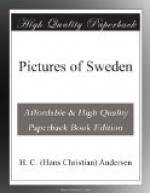In the left aisle of the church there still stands, and has stood time out of mind, a carved image of wood, painted in various colours which are still strong: it is the Virgin Mary with the child Jesus. Fresh flower wreaths are hung around hers and the child’s head; fragrant garlands are twined around the pedestal, as festive as on Madonna’s birthday feast in the times of Popery. The young folks who have been confirmed, have this day, on receiving the sacrament for the first time, ornamented this old image—nay, even set the priest’s name in flowers upon the altar; and he has, to our astonishment, let it remain there.
The image of Madonna seems to have become young by the fresh wreaths: the fragrant flowers here have a power like that of poetry—they bring back the days of past centuries to our own times. It is as if the extinguished glory around the head shone again; the flowers exhale perfume: it is as if incense again streamed through the aisles of the church—it shines around the altar as if the consecrated tapers were lighted—it is a sunbeam through the window.
The sky without has become clear: we drive again in under Cleven, the barren side of Kinnakulla: it is a rocky wall, different from almost all the others. The red stone blocks lie, strata on strata, forming fortifications with embrasures, projecting wings and round towers; but shaken, split and fallen in ruins—it is an architectural fantastic freak of nature. A brook falls gushing down from one of the highest points of the Cleven, and drives a little mill. It looks like a plaything which the mountain sprite had placed there and forgotten.
Large masses of fallen stone blocks lie dispersed round about; nature has spread them in the forms of carved cornices. The most significant way of describing Kinnakulla’s rocky wall is to call it the ruins of a mile-long Hindostanee temple: these rocks might be easily transformed by the hammer into sacred places like the Ghaut mountains at Ellara. If a Brahmin were to come to Kinnakulla’s rocky wall, he would recognise the temple of Cailasa, and find in the clefts and crevices whole representations from Ramagena and Mahabharata. If one should then speak to him in a sort of gibberish—no matter what, only that, by the help of Brockhaus’s “Conversation-Lexicon” one might mingle therein the names of some of the Indian spectacles:—Sakantala, Vikramerivati, Uttaram Ramatscheritram, &c.—the Brahmin would be completely mystified, and write in his note-book: “Kinnakulla is the remains of a temple, like those we have in Ellara; and the inhabitants themselves know the most considerable works in our oldest Sanscrit literature, and speak in an extremely spiritual manner about them.” But no Brahmin comes to the high rocky walls—not to speak of the company from the steam-boat, who are already far over the lake Venern. They have seen wood-crowned Kinnakulla, Sweden’s hanging gardens—and we also have now seen them.




